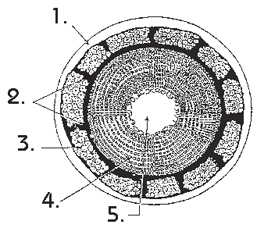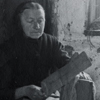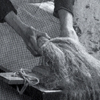
Drawing of cross section of flax stem. 1. Epidermis - 2. Fibre bundle - 3. Fibre cell 4. Xylem - 5. Hollow
Flax has been known in Denmark since the Stone Age. It is one of the oldest plants used for the production of linen fabric. Until approximately 1900, nearly all the farms in Denmark had large fields of flax to produce their own linen for sheets, tablecloths, shirts and shifts (a type of undergarment for men and women). Today, Denmark imports linen from e.g. the Baltic countries.
There are 2 types of flax: 1) Oil flax, used for the production of linseed oil. 2) Linen flax, used to produce linen. The word linen is derived from the Latin for the flax plant, which is linum, and the earlier Greek linon, and this has given rise to a number of other terms e.g. linseed oil. Linen flax is an annual plant and can grow to a height of 90cm. The plant has small blue flowers.
The drawing shows a cross section of a flax stem. Linen fabric and linen thread are produced from the plant’s fibres, called the fibre bundles










